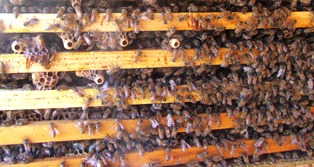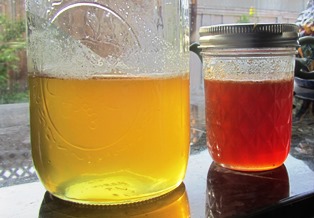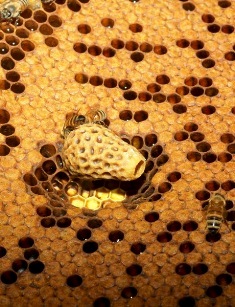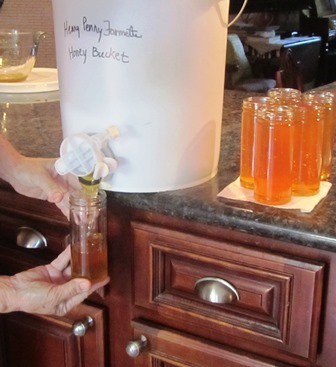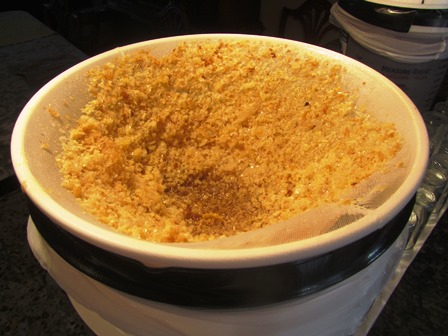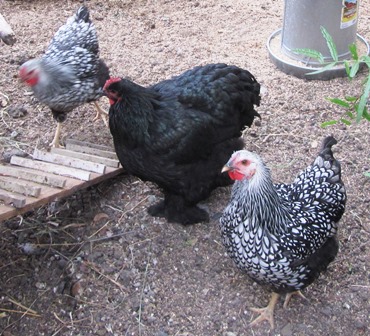Archive for the 'Wildlife' Category
The Bees Won’t Wait
With so many flowers in bloom now, it’s time to add supers to the hives.
I can hear the buzzing from my patio, about twenty to thirty feet from the hives. My bees want to make honey, raise babies, and swarm . . . I know it.
My neighbor and I are opening hives tomorrow, but I worked out in the apiary today getting extensions (known as supers) ready. These have shorter frames and the bees use them to build wax cells and store honey.
I’ve got two active hives and extras. And I have several supers, complete with the shorter frames ready to go.
There are about ten frames I can use in a super that are being housed in the outdoor freezer. It’s where I put frames to kill anything that could live over on them that I don’t want in a hive, like a wax moth. The cold kills.
I also cleaned the bee glue off another hive box with larger frames in the event the bees decide to swarm sooner rather than later. The bees won’t wait. They’ll need a new house ready when they swarm or they’ll fly away and find one elsewhere.
Preparing Honeybee Hives for Spring
Recently, I conducted a mid-winter check of my honeybee hives. With my beekeeper neighbor’s help, we opened my Henny Penny Farmette Hives A and B to search for signs of an increase in the mite population, the presence of other pests, and evidence of mold. Inspecting and treating bees with medicines when necessary are important bee management practices.
We found one bug that I couldn’t identify but my neighbor explained it lays a narrow worm and must be removed before its numbers increase. This we did. We also found three frames in Hive B that had a few spots of mold. We threw away the frames and replaced them with wax-covered frames in the lower hive box where the queen had already produced lots of bee babies.
There appeared to be adequate stores of honey, baby bee food, and lots of baby bees. In fact, we removed a few frames of honey from both hives. In their place, we inserted frames that previously had the honey drained off but wax left intact (these I always freeze before putting back into hives since freezing kills mites, larvae, and wax moth), making it easier for the bees to start building comb.
The honey I harvested is dark-colored and earthy tasting, typical of autumn honey when the bees collect pollen from eucalyptus, star thistle, and other sources available in autumn. In contrast, spring honey is light-colored and slightly citrus tasting from pollen gathered from blooming citrus trees and wildflowers.
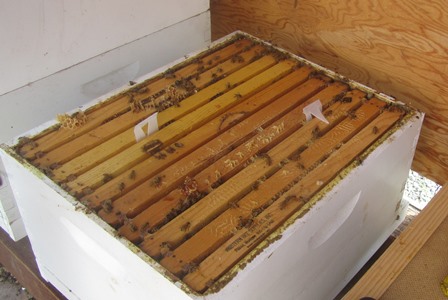
Hang medicated miticide strips between frames inward from the edge of the hive box for mite control.
Since we found evidence of mites, we hung miticide strips between frames to combat tracheal and Varroa mites. Also, we sprinkled powdered sugar medicine (Tetra-Bee Mix 2X Medicated) over the frames to control risk of American foulbrood. Treating the hives thus will enable the bees to remain robust. I expect their numbers to swell with warmer weather which, in turn, translates to new swarms in the spring.
*Apivar is an effective treatment of Varroa mites. One strip per four to five frames works through contact and should be placed in high bee activity areas. Not to be used when honey supers (top hive boxes with frames of honey) are on.
*Tetra-Bee Mix 2 X Medicated is recommended for control of American foulbrood caused by paenibacillus larvae and European foulbrood caused by streptococcus pluton susceptible to oxytetracycline in bees when used as directed.
For more beekeeping tips, delicious recipes, and a wholesome whodunnit, check out my Henny Penny Farmette cozy mysteries: A BEELINE TO MURDER (paperback release in October 2016), MURDER OF A QUEEN BEE (hardcover October 2016), and HIVE OF HOMICIDES (October 2017). Find them on Amazon.com, Barnesandnoble.com and other online and conventional bookstores everywhere.
Rainy Day Projects on the Farmette
I awoke in the pre-dawn hours to the sound of soft pattering of rain beyond my bedroom window. The birds twittered away in the pepper tree . I rolled over to listen and said a prayer of thanks that the “storm door” has finally opened. Three storms are expected to hit our drought-stricken California during this first full week of 2016.
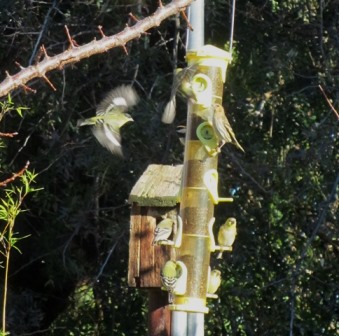
There’s always plenty of action at the feeder when the finches discover it has been filled with Nyjer seed–high in calories and oil content.
After I had swallowed a half cup of morning coffee, I headed out to the feed store to buy chicken crumble, scratch grains, and some seed and suet to hang for the birds.
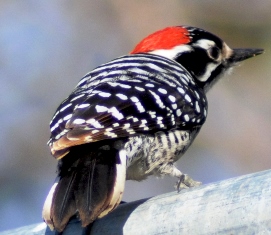
A male Nuttall’s Woodpecker loves dining on the suet cake; he hangs around all year near our pepper tree.
I won’t continue the pruning of the pomegranates and apricots that I started on Sunday. I’ll wait until we have a dry day for that. But I will continue to apply the plaster to the drywall that we’ve hung in the as-yet-unfinished small bedroom destined to become my office. That will be a perfect rainy day activity. And when I finish, I’ll go back to work on my newest mystery.
For more vignettes of farmette life, check out A Beeline to Murder, the first novel in the Henny Penny Farmette series of cozy mysteries. It’s available online and from brick-and-mortar bookstores everywhere. See, http://tinyurl.com/p8d6owd
Why Use a Screened Bottom Board in the Hive?
When beekeepers see signs that the population of Varroa destructor mites are increasing in the hive, they will take action to reduce the mite population. One way they can track mite levels is by using a screened bottom board.
A close monitoring of a screened bottom board can give a beekeeper a good idea of whether or not the mite population is increasing or decreasing in the hive.
Mites fall through the screen to the ground. A screened bottom board stretches across a platform that the hive box sits on.
When the mites in a hive fall on solid bottoms in a hive box, they can ride back up into the interior of the hive on other bees. A great article for building your own screened bottom board can be found at http://www.michiganbees.org/wp-content/uploads/2012/03/Screened-Bottom-Board_20110324.pdf
The use of a screened bottom board prevents bees returning upwards in the hive. One sign of mites at work in a hive are wings missing from newly emerged baby bees. There are other signs as well.
For lots of interesting bee “stuff” as well as farming tips and delicious recipes, check out my newest novel, A BEELINE TO MURDER.
Now available online and from brick-and-mortar bookstores everywhere. See, http://tinyurl.com/p8d6owd
A Prowling Raccoon Looking for a Warm Chicken Dinner
My farmette looks like some kind of ghostly haunt after sunset. That’s because of all the bed linen I’ve draped over citrus trees and frost-sensitive plants. On moonless nights, the backyard looks like a gathering of ghosts illuminated by the warming lamp in hanging in the hen house.
That heat lamp splays light across the back of the property. I didn’t realize right away that the claw marks in the dirt near the chicken run are from a large raccoon who, thanks to the light, now knows exactly where to find the chickens and has come prowling over the last few nights. My locks and the buried wire fencing of the chicken run are keeping the hens safe.
For the last few mornings, the water in the Italian fountain (the motor is turned off now) has been frozen and doesn’t thaw until mid-morning. Still, I see wild birds bathing in it. And we have plenty of wild birds now, thanks to twenty pounds of bird seed we’ve poured into feeders around the property.
I’m looking forward to the weather changing again in a couple of days–rain is on the way. The last storm brought a new blooms to the roses and caused the daffodils and some summer tulips to push up green shoots.
Since some of my trees perform better with a good winter chilling, I feel obliged to appreciate the cold. Besides, I can stay inside and bake, read books and seed catalogs, and write on my third cozy mystery novel.
If you enjoy reading about farmette life, you might like the farmette milieu featured in A Beeline to Murder, the first book in my Henny Penny Farmette series of cozy mysteries. See, http://tinyurl.com/p8d6owd
Gifts from the Hive
Mention beekeeping, and most folks think right away of the delicious honey that bees make. Of course, farmers and gardeners love bees because the insects pollinate the plants growing in the vicinity of their hives.
After collecting pollen, the bees make honey–nature’s sweetener. Honey adds an interesting flavor to savory dishes and is a valued ingredient in desserts. Raw honey also has medicinal value since it has a slightly acidic pH and can cause a complex reaction when used to disinfect scrapes and wounds. But honey has other uses as well.
Because honey contains lower levels of fructose (unlike refined sugars), it is less inflammatory to the stomach and digestive organs. Today, honey is widely considered a superfood, one to be consumed to maintain good health. Honey is a great ingredient for cough drops and sore throat soothers. Or, drop a spoonful into your favorite tea for a cupful of enjoyment at any time.
Comprised of tiny particles of powdery pollen gathered from flowers, bee pollen is loaded with vitamins and minerals. It also contains amino acids, enzymes, and proteins. It can be eaten in foods or on cereal as well as used as an ingredient in soap.
Beeswax makes lovely candles and soaps. Honey is often used as a vital ingredient in homemade cosmetics, bath oils, and hand cream. Of course, all these gifts from the hive are as appreciated by those who don’t keep bees as well as those who do. And since the season of gift-giving is upon us, consider buying from local beekeepers their artisanal honey and other products from the hive.
Chicken Bad Behavior–Best Nipped in the Bud
Many factors can affect the health and egg laying of your chicken flock, including weather, housing, size of population, breed, molting, parasite load, and nutrition. But when chickens start viciously pecking other hens or eating eggs, the underlying issues must be addressed.
Most often, the issue is a case of stress. Causes of chicken stress include overcrowding, excessive heat, too much bright light, lack of food and/or fresh water, and bad diet.
Other factors can include disruption of the pecking order by introducing new birds, especially those of other breeds (for example, fowl with combs and those without) or mixing old fowl with young. These factors all relate to flock management.
When birds start eating eggs (usually finding a cracked egg or broken ones, tasting them, and then pecking eggs to break them to eat) or viciously pecking on other hens, it’s best to figure out what in the hens’ environment is causing the stress. The causes must be eliminated.
For more tips on farming and beekeeping, plus delicious recipes, check out my newest mystery–A BEELINE TO MURDER. See, http://tinyurl.com/p8d6owd
Blankets for Trees & Bees on Frosty Nights
I don’t like to take chances with my citrus trees when overnight temperatures drop to near freezing. I cover them with sheets and blankets.
My hives are in a wooden shelter with a tin roof and the back side open, so I can work without any encumbrance. But I don’t want the bees to have to work harder to keep the hive warm for the queen and babies, so I throw some blankets over my beehives, too.
Also, on particularly cold nights, I hang a warming lamp in my chicken house. My rule of thumb for my hens is when overnight temperatures are expected to drop below 45 degrees, I turn on the lamp so the hens aren’t stressed.
An advantage of hanging a heat lamp in the chicken house is to foster egg laying at time when shorter days of light slows egg production. The heat lamp makes light available to the chickens for a much longer period.
Update: The Henny Penny Farmette “Name that Cat” Contest
Here’s the update: We have a winning name for the cat–Cuddy (for cuddly and cutie and clever and kitty,-kitty). Winner has been notified and a free copy of A BEELINE TO MURDER in a tote bag has been mailed. We thank all who entered for their cat name suggestions.
The original post follows here:
Despite Holly Golightly calling her feline companion “Cat” in the the Blake Edward’s film, Breakfast at Tiffany’s, cat lovers everywhere were probably cringing. Cats are as unique as the people who own them and, I believe, every cat should have a special name.
Recently, I adopted a beautiful unnamed cat from our local animal shelter to live with me on my Henny Penny Farmette. Only a year old and possibly abandoned or a runaway, she’d been found in a field. She was hungry, cold, and frightened.
Immediately, she was checked to see if she had been spayed, and she reacted defensively. The behavior earned her an “unadoptable” status, except to a cat rescue organization. I lobbied the shelter staff to let me adopt her. They did.
Now I need a name for her Highness, and I think a contest might be the way to find that perfect name.
Here’s a little info about her to help you dream up the perfect name.
- * She’s eager to give and receive affection, intelligent, and curious.
- * She bears herself as though she were royalty
- * She even looks regal–her animal shelter card states her breeding is believed to be a Siamese mixed with American domestic short hair.
- * Her coloring is cream and lavender-gray
- *She loves playing with kitty toys
- *She sniffed all the books in my bookcase the first time she entered the house. (Methinks she likes being around books and writers)
- *The window ledge overlooking the garden where the chickens, squirrels, and wild birds freely roam is her throne.
CONTEST RULES: The contest begins at midnight Friday, November 6, and ends on Thursday, November 19 at midnight. The winner will be announced on Friday, November 20 at 12 noon (Pacific Standard Time).
PRIZE: The winner will receive a free copy of A BEELINE TO MURDER novel and a tote bag.
TO ENTER: Simply send an email to: Meera@hennypennyfarmette.com with your name and snail mail address and your perfect name for my cat. Limited to one name per entry, one entry per person. In the event, multiple people send the chosen name, the first person to have emailed it will be declared the winner.
And who knows–this cat may become a character in one of my future cozy mysteries. Check out the Henny Penny Farmette series of cozies, starting with A BEELINE TO MURDER (my debut novel). See, http://tinyurl.com/nkn4vh3
Resources to Assist Pet Owners in Tough Times
I always learn a lot from my regular visits to the Contra Costa County Animal Shelter. I was surprised to learn that the shelter doesn’t take in just dogs and cats but also chickens, guinea pigs, rabbits, and other animals.

Moose isn’t a shelter animal but a very pampered pet belonging to my daughter’s family–some dogs in Contra Costa County are not so fortunate
But most alarming for me was learning that some people in our current economy are having trouble paying for their pets’ required shots or annual license renewal. Others, for a variety of reasons, may need food for their pets. In tough times, pets can suffer, too.
Thanks to generous donations within Contra Costa County, the shelter is happy to share (when available) the pet food that is donated. That said, the shelter urges all pet owners to have backup plans in case the shelter’s donated supplies are running low.

This little cutie is one at the shelter I fell in love with; I picked out a name, returned to adopt, and someone had already claimed him
If you are a pet owner needing assistance with getting pet food and your Plan A didn’t work out, you might consider the following Plan-B, Plan-C, and Plan-D.
Plan-B: Contra Costa Humane Society Ani-meals Program
Phone: (925) 676-7543 or 1 (800) 870-3663
Plan-C: Tony LaRussa’s ARF Food Relief Program
Phone (925) 256-1273, ext. 463; website: http://www.arf.net/animal-programs/foodshare
The ARF program also helps people in their program with spay and neuter services.
Plan-D: Furry Friends Food Relief Program:
Phone (925) 240-3178; website: http://www.furryfriendsfoodre.wix.com/fffr
If you love animals and would like to help families and their pets who might be struggling, consider donating money, pet food, or your time to your local animal shelter. Shelter staff members and volunteers give phenomenal care to the creatures who cannot fend for themselves.
The shelter will hold the animals for a while or relocate them with rescue organizations or find them temporary foster homes. The best outcome is adoption into a forever family home. In Contra Costa County, people with questions about food distribution programs can call the Humane Education Department at (925)-335-8340.
 Facebook
Facebook Goodreads
Goodreads LinkedIn
LinkedIn Meera Lester
Meera Lester Twitter
Twitter




